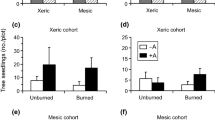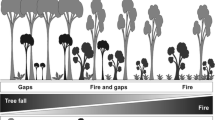Abstract
Predicting changes in vegetation structure in fire-prone arid/semi-arid systems is fraught with uncertainty because the limiting factors to coexistence between grasses and woody plants are unknown. We investigated abiotic and biotic factors influencing boundaries and habitat membership in grassland (Triodia or ‘spinifex’ grassland)-shrubland (Acacia aneura or ‘mulga’ shrubland) mosaics in semi-arid central Australia. We used a field experiment to test for the effects of: (1) topographic relief (dune/swale habitat), (2) adult neighbour removal, and (3) soil type (sand/clay) on seedling survival in three shrub and two grass species in reciprocal field plantings. Our results showed that invasion of the shrubland (swale) by neighbouring grassland species is negated by abiotic limitations but competition limits shrubland invasion of the grassland (dune). All species from both habitats had significantly reduced survival in the grassland (dune) in the presence of the dominant grass (Triodia) regardless of soil type or shade. Further, the removal of the dominant grass allowed the shrubland dominant (A. aneura) to establish outside its usual range. Seedling growth and sexual maturation of the shrubland dominant (A. aneura) was slow, implying that repeated fire creates an immaturity risk for this non-sprouter in flammable grassland. By contrast, rapid growth and seed set in the grassland shrubs (facultative sprouters) provides a solution to fire exposure prior to reproductive onset. In terms of landscape dynamics, we argue that grass competition and fire effects are important constraints on shrubland patch expansion, but that their relative importance will vary spatially throughout the landscape because of spatial and temporal rainfall variability.





Similar content being viewed by others
References
Allan GE (1993) The fire history of central Australia. CSIRO/CCNT Bushfire Research Project, vol 4. CSIRO/CCNT technical report. CSIRO, Alice Springs
Allan GE, Southgate R (2002) Fire regimes in the spinifex landscapes of Australia. In: Bradstock RB, Williams JE, Gill AM (eds) Flammable Australia: fire regimes and the biodiversity of a continent. Cambridge University Press, Cambridge, pp 145–176
Bond WJ (2008) What limits trees in C4 grasslands and savannas? Annu Rev Ecol Evol Syst 39:641–659
Bond WJ, Keeley JE (2005) Fire as a global ‘herbivore’: the ecology and evolution of flammable ecosystems. Trends Ecol Evol 20:387–394
Bowman DMJS, Latz PK, Panton WJ (1994) Pattern and change in an Acacia aneura shrubland and Triodia hummock grassland mosaic on rolling hills in central Australia. Aust J Bot 43:25–37
Bowman DJMS, Boggs GS, Prior LD, Krull ES (2007) Dynamics of Acacia aneura–Triodia boundaries using carbon (14C and δ13C) and nitrogen (δ15N) signatures in soil organic matter in central Australia. Holocene 17:311–318
Bowman DJMS, Boggs GS, Prior LD (2008) Fire maintains an Acacia aneura shrubland–Triodia grassland mosaic in central Australia. J Arid Environ 72:34–47
Buckley RC (1979) Soils and vegetation of central Australian sandridges. PhD thesis, Australian National University, Canberra
Buckley RC (1981) Soils and vegetation of central Australian sandridges. III. Sandridge vegetation of the Simpson Desert. Aust J Ecol 6:405–422
Buckley RC (1982) Soils and vegetation of central Australian sandridges IV. Soils. Aust J Ecol 7:187–200
Bureau of Meteorology (2009) Climate. Cited 6 April 2009. Available from URL:http://www.bom.gov.au/climate.htm
Griffin GF (1990) Characteristics of three spinifex alliances in central Australia. J Veg Sci 1:435–444
Grigg AM, Veneklaas EJ, Lambers H (2008) Water relations and mineral nutrition of closely related woody plants species on desert dunes and interdunes. Aust J Bot 56:27–43
Harrington GN (1991) Effects of soil moisture on shrub seedling survival in a semi-arid grassland. Ecology 72:1138–1149
Drewa PB, Peters PC, Havstad, KM (2001) Fire, grazing, and honey mesquite invasion in black grama-dominated grasslands of the Chihuahuan Desert: a synthesis. In: Galley KEM, Wilson TP (eds) Proceedings of the invasive species workshop: the role of fire in the control and spread of invasive species. Fire Conference 2000: the First National Congress on Fire Ecology, Prevention and Management. Miscellaneous publications no. 11. Tall Timbers Research Station, Tallahassee
Higgins SI, Bond WJ, Trollope WSW (2000) Fire, resprouting and variability: a recipe for grass-tree coexistence in savanna. J Ecol 88:213–229
Higgins SI, Bond WJ, February EC, Bronn A, Euston-Brown DIW, Enslin B, Govender N, Rademan L, O’Regan S, Potgieter ALF, Scheiter S, Sowry R, Trollope L, Trollope WSW (2007) Effects of four decades of fire manipulation on woody vegetation structure in savanna. Ecology 88:1119–1125
Hodgkinson KC, Griffin GF (1982) Adaptation of shrub species to fires in the arid zone. In: Barker WR, Greenslade PJM (eds) Evolution of the flora and fauna of arid Australia. Peacock, Australian Systematic Botany Society, ANZAAS, South Australian Division, Frewville, South Australia, pp 145–152
Keeley J, Fotheringham C (2000) Role of fire in regeneration from seed. In: Fenner M (ed) Seeds: the ecology of regeneration in plant communities. CABI, Wallingford, UK, pp 311–330
Kraaij T, Ward D (2006) Effects of rain, fire and grazing on tree recruitment and early survival in bush-encroached savanna, South Africa. Plant Ecol 186:235–246
Lazarides M (1997) A revision of Triodia including Plectrachne (Poaceae, Eragrostideae, Triodiinae). Aust Syst Bot 10:381–489
Litchfield WH (1962) Soils of the Alice Springs area. In: Perry RA (ed) General report on the lands of the Alice Springs area, Northern Territory 1956–57. CSIRO, Melbourne, pp 185–207
Nano CEM (2005) Within- and between-habitat coexistence in mulga (Acacia aneura) shrubland-spinifex (Triodia spp.) hummock grassland mosaics in central Australia. PhD thesis, University of New England, Armidale, NSW, Australia
Nano CEM, Clarke PJ (2008) Variegated desert vegetation: covariation of edaphic and fire variables provides a framework for understanding mulga-spinifex coexistence. Austral Ecol 33:848–862
Noble IR, Slatyer RO (1980) The use of vital attributes to predict successional changes in plant communities subject to recurrent disturbance. Vegetation 43:5–21
Noble JC, Peltier R, Montagne P, Mahamane EHL (2001) Toward improved management of arid and semiarid banded landscapes. In: Tongway DJ, Valentin C, Seghieri J (eds) Banded vegetation patterning in arid and semiarid environments ecological processes and consequences for management. Springer, New York, pp 210–227
Noy-Meir I (1973) Desert ecosystems: environment and producers. Annu Rev Ecol Syst 4:51–58
Perry RA, Litchfield WH, Quinlan T (1962) Land systems of the Alice Springs area. In: Perry RA (ed) General report on the lands of the Alice Springs area, Northern Territory 1956–57. CSIRO, Melbourne, pp 208–236
Peters DPC, Gosz JR, Pockman WT, Small EE, Parmenter RR, Collins SL, Muldavin E (2006) Integrating patch and boundary dynamics to understand and predict biotic transitions at multiple scales. Landsc Ecol 21:19–33
Pressland AJ (1975) Productivity and management of mulga in south-western Queensland in relation to tree structure and density. Aust J Bot 23:965–976
Quinn GP, Keough MJ (2001) Experimental design and data analysis for biologists. Cambridge University Press, UK
Rajaniemi TK, Allison VJ, Goldberg DE (2003) Root competition can cause a decline in diversity with increased productivity. J Ecol 91:407–416
Reid N, Hill SM, Lewis DM (2008) Spinifex biogeochemical expressions of buried gold mineralisation: the great mineral exploration penetrator of transported regolith. Appl Geochem 23:76–84
Sankaran M, Ratnam J, Hanan NP (2004) Tree-grass coexistence in savannas revisited–insights from an examination of assumptions and mechanisms invoked in existing models. Ecol Lett 7:480–490
Sankaran M, Ratnam J, Hanan NP (2007) Woody cover in African savannas: the role of resources, fire and herbivory. Global Ecol Biogeogr 17:236–245
Schlesinger WH, Reynolds JF, Cunningham GL, Huenneke LF, Jarrell WM, Ross AV, Whitford WG (1990) Biological feedbacks in global desertification. Science 247:246–247
Scholes RJ, Archer SR (1997) Tree–grass interactions in savannas. Annu Rev Ecol Syst 28:517–544
Sperry JS, Hacke UG (2002) Desert shrub water relations with respect to soil characteristics and plant functional type. Funct Ecol 16:367–378
Squeo FA, Holmgren M, Jiménez M, Albán L, Reyes J, Gutiérrez JR (2007) Tree establishment along an ENSO experimental gradient in the Atacama desert. J Veg Sci 18:195–202
Tongway DJ, Ludwig JA (1990) Vegetation and soil patterning in semi-arid mulga lands of eastern Australia. Aust J Ecol 15:23–34
Tongway DJ, Ludwig JA (1997) The nature of landscape dysfunction in rangelands. In: Luwig J, Tongway D, Fruendberger D, Noble J, Hodgkinson K (eds) Landscape ecology, function and management: principles from Australia’s rangelands. CSIRO, Collingwood, pp 49–61
Tongway DJ, Ludwig JA (2001) Theories on the origins, maintenance, dynamics and functioning of banded landscapes. In: Tongway DJ, Valentin C, Seghieri J (eds) Banded vegetation patterning in arid and semiarid environments ecological processes and consequences for management. Springer, New York, pp 20–31
Turner D, Ostendorf B, Lewis D (2008) An introduction to patterns of fire in arid and semi-arid Australia, 1998–2004. Rangel J 30:95–107
Whitford WG (2002) Ecology of desert systems. Academic Press, London
Wiegand K, Ward D, Saltz D (2005) Multi-scale patterns and bush encroachment in an arid savanna with a shallow soil layer. J Veg Sci 16:311–320
Wiegand K, Saltz D, Ward D (2006) A patch-dynamics approach to savanna dynamics and woody plant encroachment–insights from an arid savanna. Perspect Plant Ecol Evol Syst 7:229–242
Wilson JB (1988) Shoot competition and root competition. J Appl Ecol 25:279–296
Wilson BA, Brocklehurst PS, Clark MJ, Dickinson KJM (1990) Vegetation survey of the Northern Territory. Parks and Wildlife Commission of the Northern Territory, Darwin, Australia
Wright BR, Clarke PJ (2007) Resprouting responses of Acacia shrubs in the western desert of Australia; fire severity, interval and season influence survival. Int J Wildl Fire 16:317–323
Wu XB, Archer S (2005) Scale-dependent influence of topography-based hydrological features on patterns of woody plant encroachment in savanna landscapes. Landsc Ecol 20:733–742
Acknowledgments
This study was funded by an Australian Post Graduate Award and a NCW Beadle scholarship and the Keith and Dorothy MacKay scholarship to C. E. M. N. We thank the Department of Natural Resources, Environment, Arts and Sport of the Northern Territory Government for providing vehicles, equipment and staff time. We are grateful to the staff of the Alice Springs Desert Park who provided essential help with plant propagation and the establishment of this experiment. We are further indebted to the volunteer staff of the Northern Territory Bushfires Council for supplying water for the experiment. Thanks also to Chris Pavey and anonymous referees who have improved the manuscript and facilitated its publication. This work complies with the current laws of the Commonwealth of Australia.
Author information
Authors and Affiliations
Corresponding author
Additional information
Communicated by Mercedes Bustamante.
Rights and permissions
About this article
Cite this article
Nano, C.E.M., Clarke, P.J. Woody-grass ratios in a grassy arid system are limited by multi-causal interactions of abiotic constraint, competition and fire. Oecologia 162, 719–732 (2010). https://doi.org/10.1007/s00442-009-1477-8
Received:
Accepted:
Published:
Issue Date:
DOI: https://doi.org/10.1007/s00442-009-1477-8




